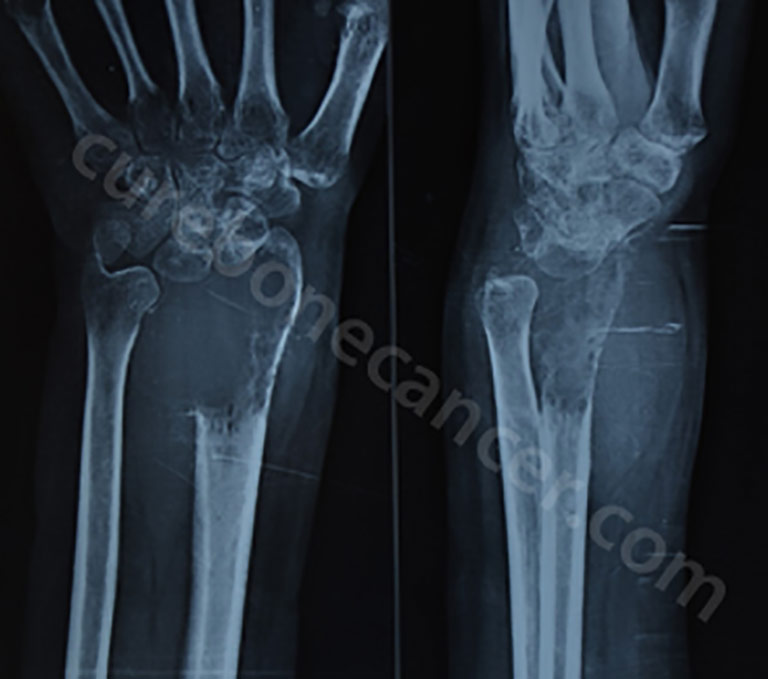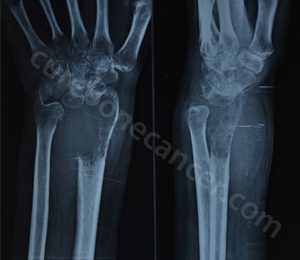What’s GIANT CELL TUMOUR (GCT) ?
GIANT CELL TUMOUR (GCT) of bone is a type of non-cancerous (benign) tumour. Most commonly, it occurs around the knee, although it can occur in any bone. Usually, it occurs at the ends of long bones.
GCTs usually occurs in young adults (between ages of 20-40 years), more common among females. Though non-cancerous, GCTs are locally aggressive tumours of bone. They almost always require surgery for treatment.
What are the symptoms of Giant Cell Tumour (GCT)?
GCT commonly presents with pain around the involved bone which worsensover time. Pain may also be accompanied by localised swelling. Sometimes, the bone weakened by bone breaks and cause sudden increase in the pain.
What causes Giant Cell Tumour (GCT)?
As of now, the cause of GCT is not known. There are no known environmental or hereditary factors which cause GCT.
What are the tests needed to confirm the diagnosis of Giant Cell Tumour (GCT)?
After thorough physical examination, your doctor would order X-rays and a MRI. X-rays typically show a destructive (lytic) lesion in the bone involved. Once scans are completed, you’ll need to undergo a biopsy to confirm the diagnosis.
What is biopsy? Who should do the biopsy?
In biopsy, some part of tumour tissue is removed and sent for examination under microscope. It can be open biopsy (in which a surgical incision is made to expose the tumorous bone and take out the diseased tissue) or a needle biopsy (in which a thin needle is used to take out the tissue without any incision). Since needle biopsy doesn’t involve any incision, the surgical trauma, pain and morbidity are lesser with needle biopsy.
One must also understand that needle biopsy is not synonymous with FNAC though both are done with a needle. FNAC has no role in the diagnosis of Giant Cell Tumour (GCT).
Since the location and technical aspects of biopsy can affect the treatment options and final outcome of the patient, biopsy should always be done by Orthopaedic Oncologist (specialist who treats bone and soft tissue tumours) or one of his team members.
Do all patients need biopsy in a case of suspected Giant Cell Tumour (GCT)?
Yes, every patient of suspected Giant Cell Tumour should be confirmed by biopsy because many a times the appearance of Giant Cell Tumour (GCT) can be mimicked by the more dangerous cancers of the bone (Sarcomas) and any unplanned surgery without a biopsy can not only compromise the future limb saving surgery but also can be detrimental for the life of the patient. In short, there are no shortcuts when it comes to managing any bone tumour and every patient of suspected GCT should be biopsied before any definitive surgery.
How is Giant Cell Tumour treated?
Surgery is the preferred mode of treatment for GCT. However, in GCTs at certain locations, your doctor may opt for non-surgical treatment in the form of tumour embolization and/or serial injections of bone strengthening agents. We at Cure Bone Cancer Clinic, Chandigarh, Giant Cell Tumour Bone Treatment in India in which treatment is customised for each patient based on his age, location of tumour, extent of bone destruction, functional demands of the patient and so on.
What kind of surgery is performed in Giant Cell Tumours?
The surgery required for treating GCTs depends on
- Age of the patient
- Location of the tumour
- Size of the tumour
- Condition of nearby joint
- No of prior surgeries (if any) for the same problem.
Surgery can be in the form of
Extended curettage, in which the tumour is scraped out with special instruments and high speed burr and the defect is filled with bone cement or bone graft or both.
OR
Wide resection, in which the tumorous bone is removed enbloc (in one piece) and the defect is reconstructed with artificial implant or bone as per the case scenario.
What are the treatment outcomes?
The outcome depends on
- The type of treatment
- Location of tumour
GCTs can recur in some patients and hence, it’s important to follow up with your doctor regularly for first 3 years atleast. Your doctor will get your x-rays on your follow up visits to look for any possible recurrence.
Dr Rajat Gupta
Orthopaedic Oncologist
Bone Cancer Clinic
# 5, Sector 19 A, Chandigarh
https://goo.gl/maps/KT5hkxsRVy12
SCO 141 (Backside), Sector 14, Panchkula
https://goo.gl/maps/aLdmMwMqvMumVXe76


